Module "Footnote text component"
1New footnotes concept
Footnotes in SMASHDOCs are no longer managed in a standard way but have been transformed to the so-called "Footnote text components" visible right in the editor under the component it relates to. Such a component is similar to the text component, but does have minor differences, namely:
●you cannot insert footnotes, side notes and checkboxes in the footnote text component;
●you can not use a page break or page format separator
●you can not change the paragraph format;
●you can not drag&drop footnote text components.
A footnote text component is instantly recognizable in the text as it has a dedicated styling including a consecutive separately counted numbering.
The footnote text components may look differently depending on their styling settings. For instance, they could look like this:
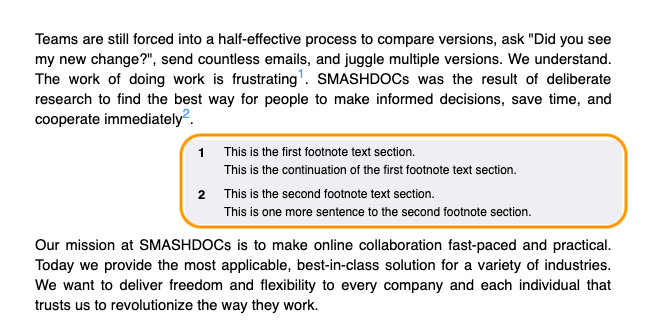
Footnote text components each containing two lines highlighted
2Connection of footnote text components and text components
The footnote text component is always connected to the component where the footnote reference has been set - their leading component. Hence, if you move the leading component by either drag&drop, copy&paste or cut&paste, the footnote text components will also be moved. In this case, SMASHDOCs will automatically adjust the numbering of the moved footnote text components.
Please keep in mind that the footnote text component itself can be moved by neither dragging and dropping, nor copying and pasting. Once you select the text component with footnote references or footnote text components themselves for moving inside of the document, they will be selected as one unit component.
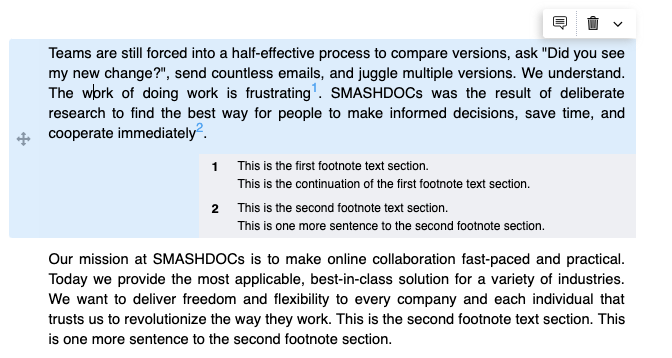
Selected leading text component and footnote text components highlighted
3Create a footnote
To create a footnote, you have to be an authorized user in the document, meaning you should have either Suggest or Approver rights. If this prerequisite is met, click at the desired position inside the leading text component and then on the "Add footnote" button in the toolbar.
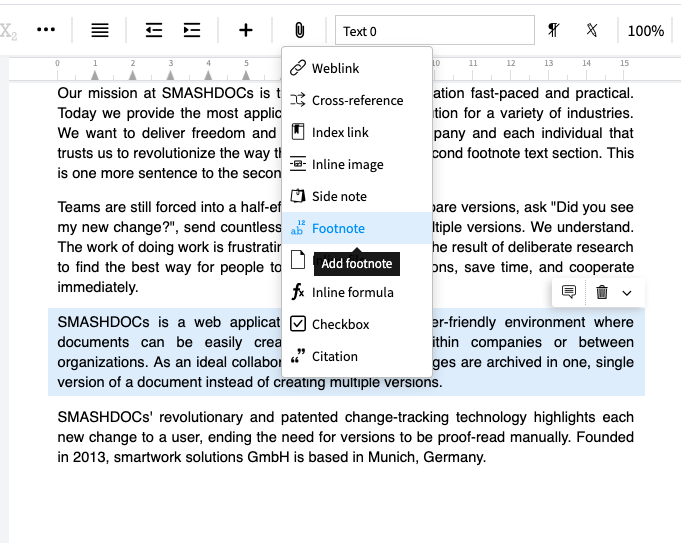
Button "Add footnote" highlighted in the toolbar
A new footnote text component will be created below the chosen leading text component. If your document is already in the review mode, the footnote text component will firstly be created as a draft component and can be released for review separately from the leading component.

Leading text component and footnote text component highlighted in the draft modes
As soon as a created footnote is revealed for review, as unseen changes for other users in the document, footnote text component and its number in the leading component it refers to will be displayed with the yellow background and with two separate blue eye signs in front of both leading component with a number and corresponding footnote component.
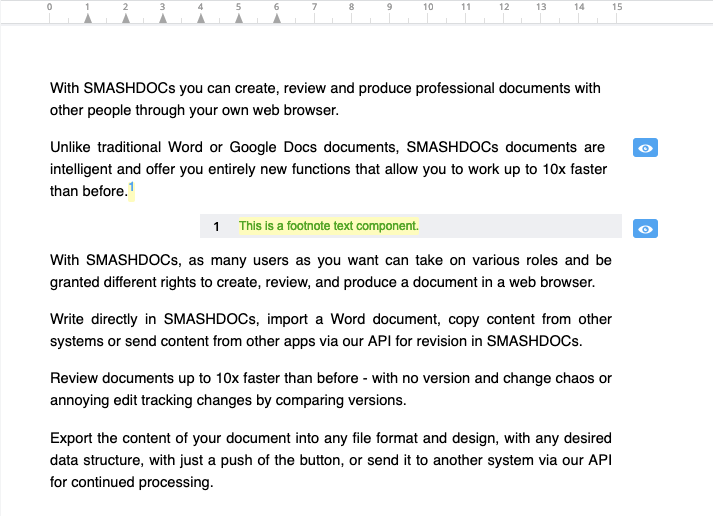
New added footnote displayed for other users in the document
If you, later on, create one more footnote, depending on the chosen reference position in the leading component, SMASHDOCs will automatically organize the correct order of footnotes in the global list of footnote text components. Same applies to the case if you add a new footnote in the leading text component that has already got a footnote text component.
All inserted footnotes are tracked in the component history of the leading component with a special footnote icon.

Icon for tracking footnotes in the component history
This icon is visible in this way, as soon as a footnote text component has been inserted as a draft component, shared for the review or been accepted.
Note: numbers in the footnote icon do not perform a function of a footnote counter and are the same in each footnote icon.
3.1Automatic positioning of footnotes
Let's say, your leading component has already got three footnotes. It looks like this:
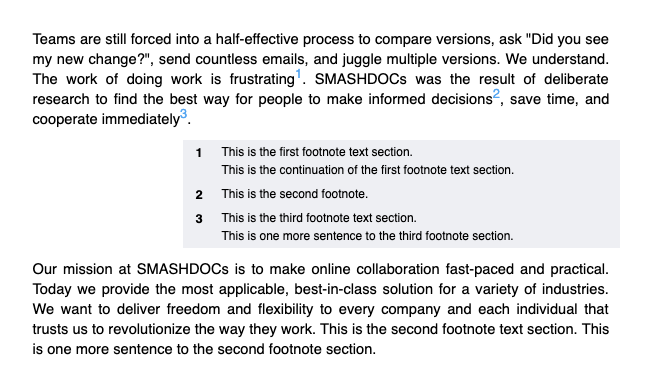
Leading text component with three footnotes highlighted
You now go back to the leading component and add a new footnote between the second and third footnote. Once you do it, the list of footnote text components will look like this:
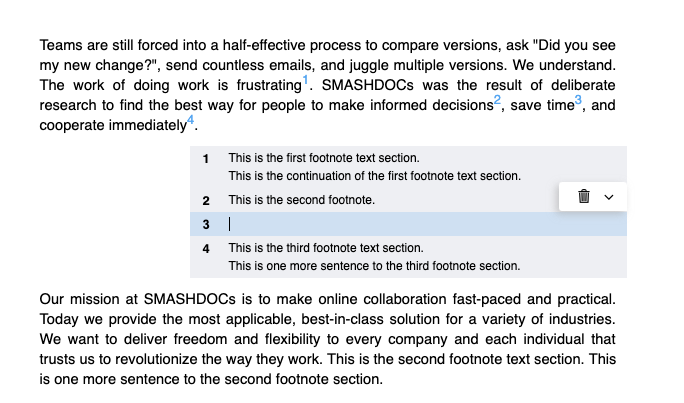
List of footnote text components with newly created footnote text component highlighted
A new footnote text component will automatically be rightly positioned in the list of footnote text components, and the cursor in it will get instantly active so that you can immediately start typing or inserting your footnote text.
4Clicking on footnote references
4.1Clicking on footnote references in a leading component
If you click on a footnote reference in the text component, you will be navigated to the corresponding footnote text component in the text, while a particular footnote will also be selected in the list of footnote text components if there are many.
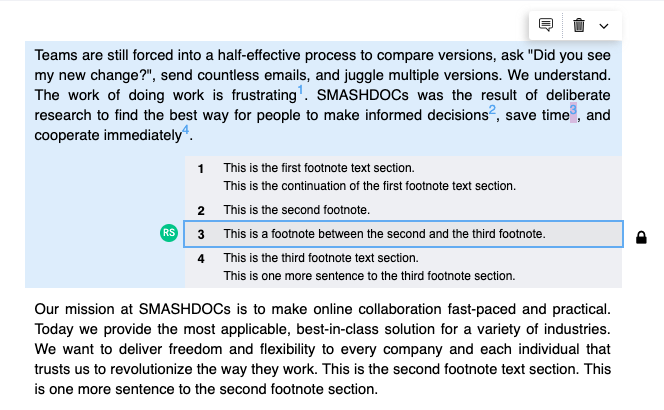
Selected footnote text component after click in a footnote reference in the leading component highlighted
4.2Clicking on footnote references in the footnote directory
Same goes if you click on a footnote reference in the directory of all footnotes in the document. You will be navigated to the corresponding footnote in the text straight away.
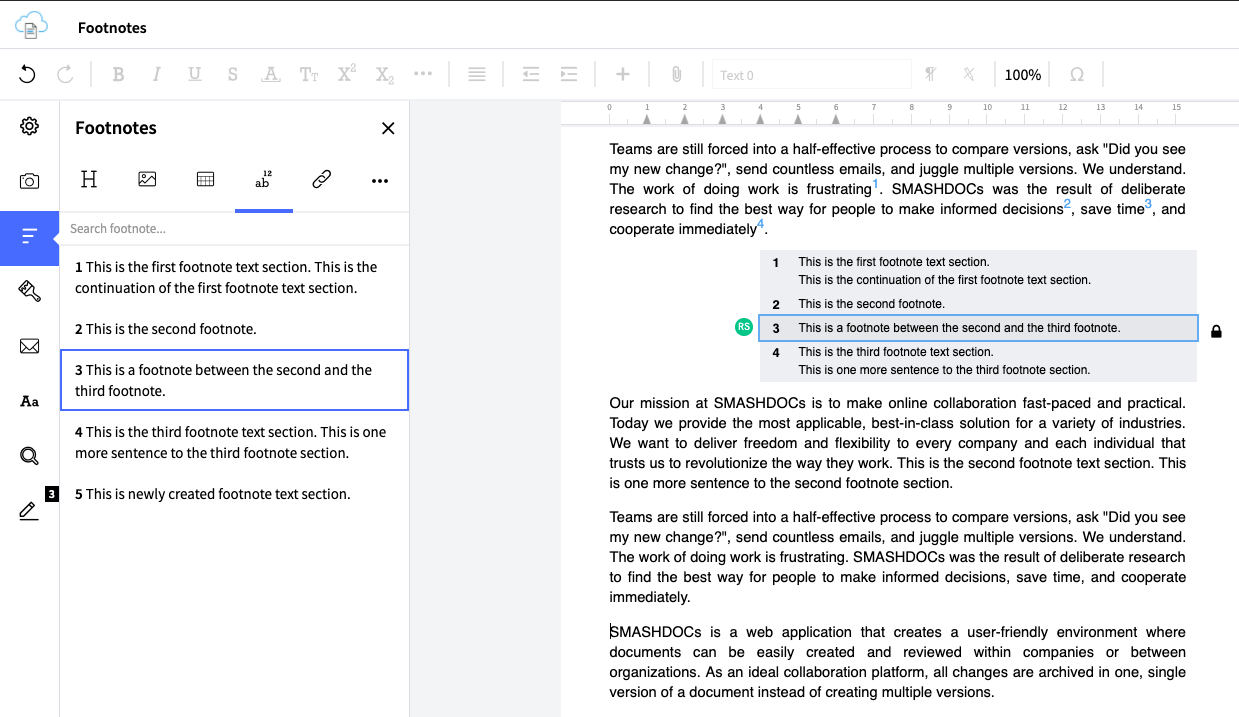
Selected footnote text component highlighted after clicking on a footnote in the global directory of footnotes in the document
5Edit footnotes
To be able to edit footnote text components, you have to possess such rights in the document as Suggest or Approver. The editing of the footnote text components is the same as editing of a normal text component. Yet, there is a special case if you want to add line breaks or more lines to the particular footnote text component.
As soon as you change the content of a footnote, it will be tracked in the footnote component history, separately from a leading component.
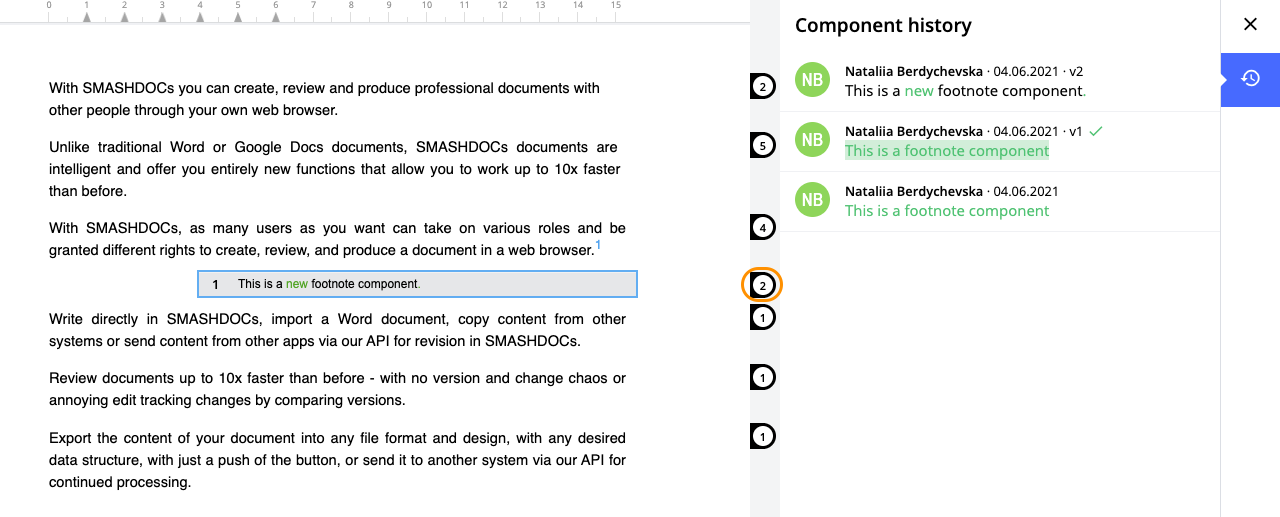
Tracking changes in a footnote component
As unseen changes, for other users that participate in editing the document content changes in footnotes, as well as inserting/deleting a footnote text component, will be displayed with a blue eye sign in front of a corresponding footnote and with yellow background.
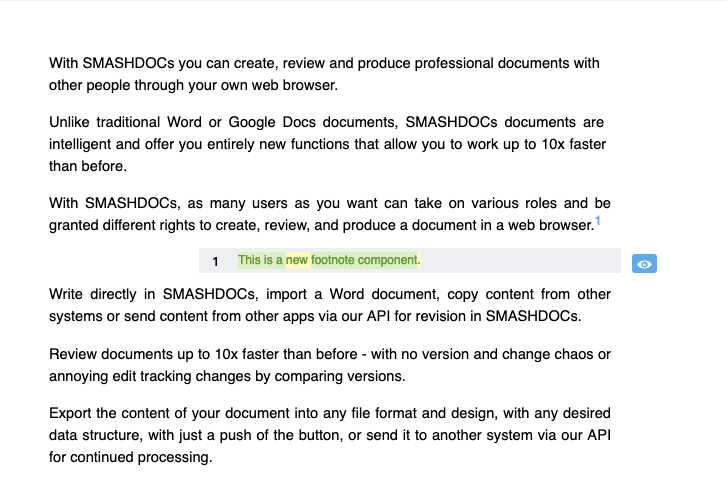
Changes in a footnote displayed for other users in a document
5.1Inserting cross-references to the other footnote text components
Cross-references can be created with the referencing to footnotes inside the footnote components. Select the corresponding footnote, choose a position where cross-reference should be inserted and perform the option "Insert cross-reference".
In the opened modal window select the tab "Footnotes" and choose the required reference targets among suggested footnotes.
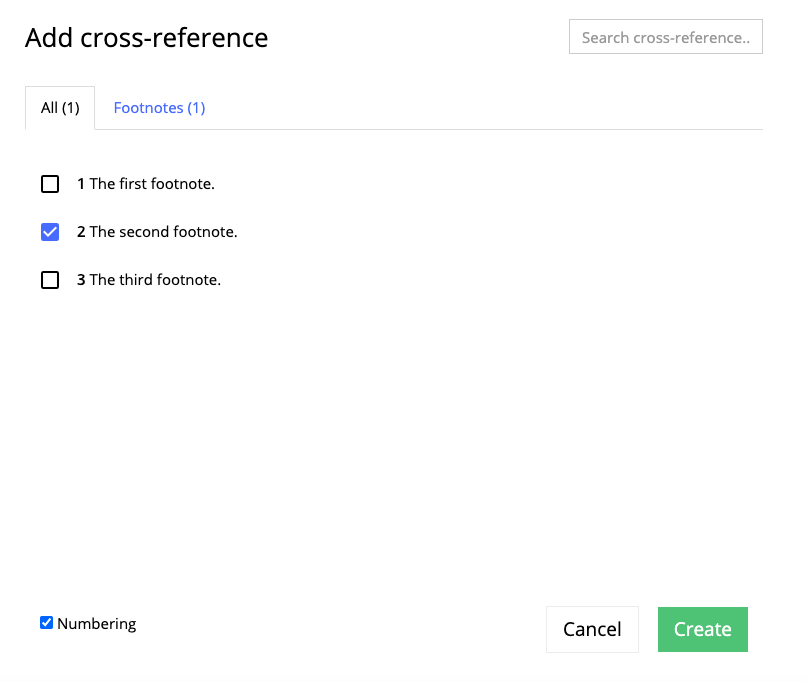
Adding cross-reference with footnote reference
Remember: footnote reference targets can be displayed in the text only as numbering.
5.2Adding line breaks in the footnote text component
To add line breaks within your footnote text component, you have to use a so-called Soft Return - the combination of Return and Shift.
Depending on the position of the cursor in the footnote text component while hitting the Soft Return combination, the footnote text component will be divided respectively. Let's say you hit Soft Return in the middle of the text content of your footnote. It will then look like this:
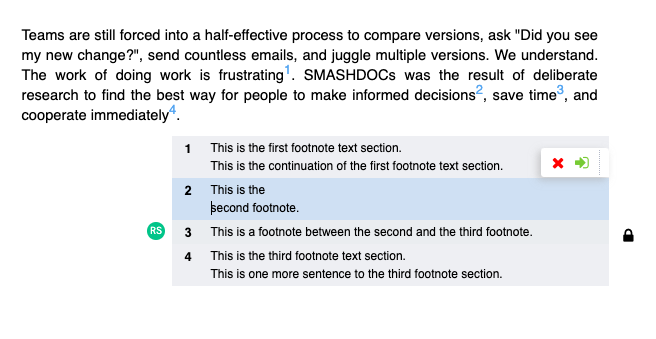
Soft return hit in the middle of the footnote text component highlighted
5.3Adding more lines in the footnote text component
Instead, you if hit Soft Return in the end of the footnote text component, an additional line for this particular footnote component will appear.
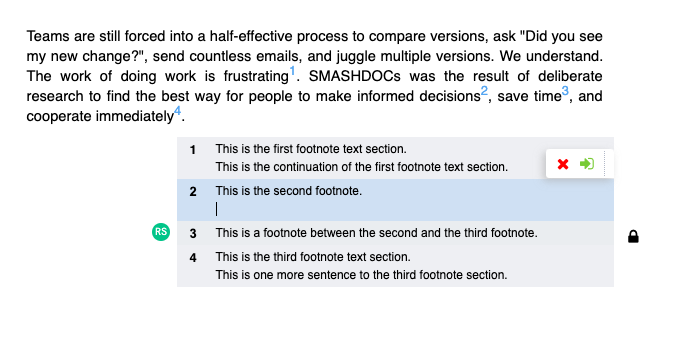
Second line in the footnote text component highlighted after hitting Soft Return in the end of the footnote
Keep hitting Soft Return as many times as many lines in your footnote you need.
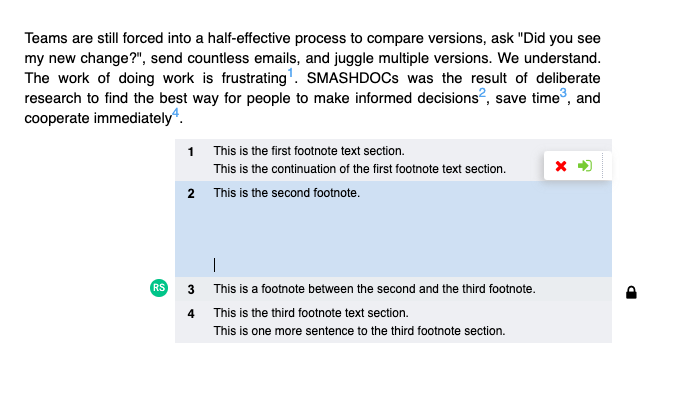
Multiple additional lines highlighted in the footnote text component after hitting Soft Return multiple times
If you have created too many empty lines, you can quickly delete them by hitting the Delete button.
5.4Hitting Return in footnotes
If you click Return somewhere in your footnote, a new draft text component will be created below the list of connected with the leading text component footnotes. Therefore, the paragraph style of the newly created component is controlled by the settings of the leading component. In our example, a new text component has got a paragraph style "Text 0".
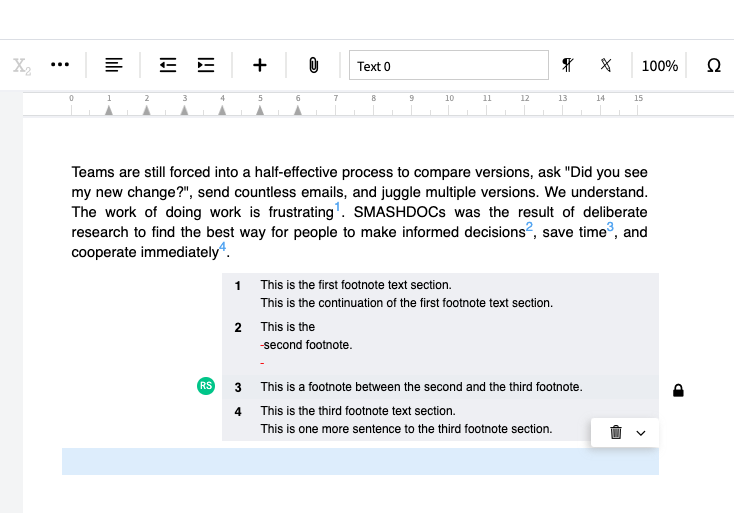
Newly created text component highlighted after hitting Return in the footnote text component
6Delete footnotes
You can delete a footnote text component in the same way as a normal text component.
When you delete a footnote and accept this deletion, the icon in the component history will be displayed as struck through with the redline.

Display of deleted footnote in the component history
As an unseen change, a sign of a footnote that has been deleted and accepted, will be displayed for other users in a document with a yellow background in a leading text component.
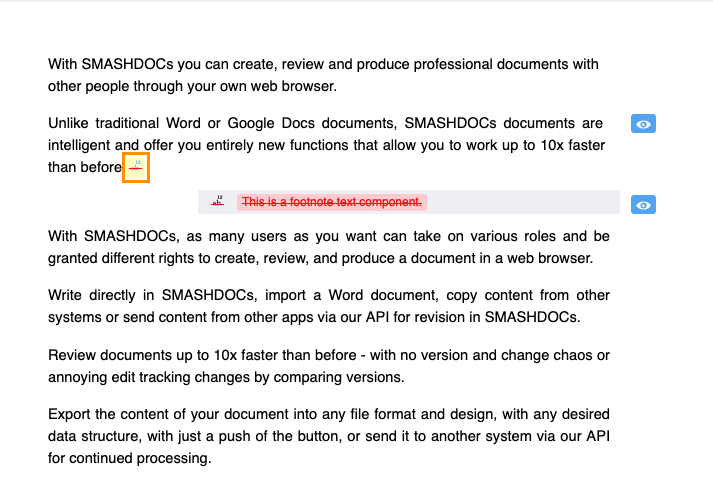
A sign of a deleted footnote in a leading text component displayed for other users as an unseen change
Note: After the final deletion of your footnote text components, the footnote references in your document will be deleted automatically, and all footnote text component numberings will be recalculated by SMASHDOCs.
7List of footnotes to the text component
Since all footnotes are now visible right under the component with footnote references and you can have their overview directly while scrolling in the text, there is no additional list of footnotes to the particular text component.
8Footnotes to a table component
Same as for creating footnotes to the text components, to add footnotes to the table components you should be an authorized user - have Suggest or Approver rights in the document.
Once you have opened the table, the footnote creation process is done in the text box right next to it.
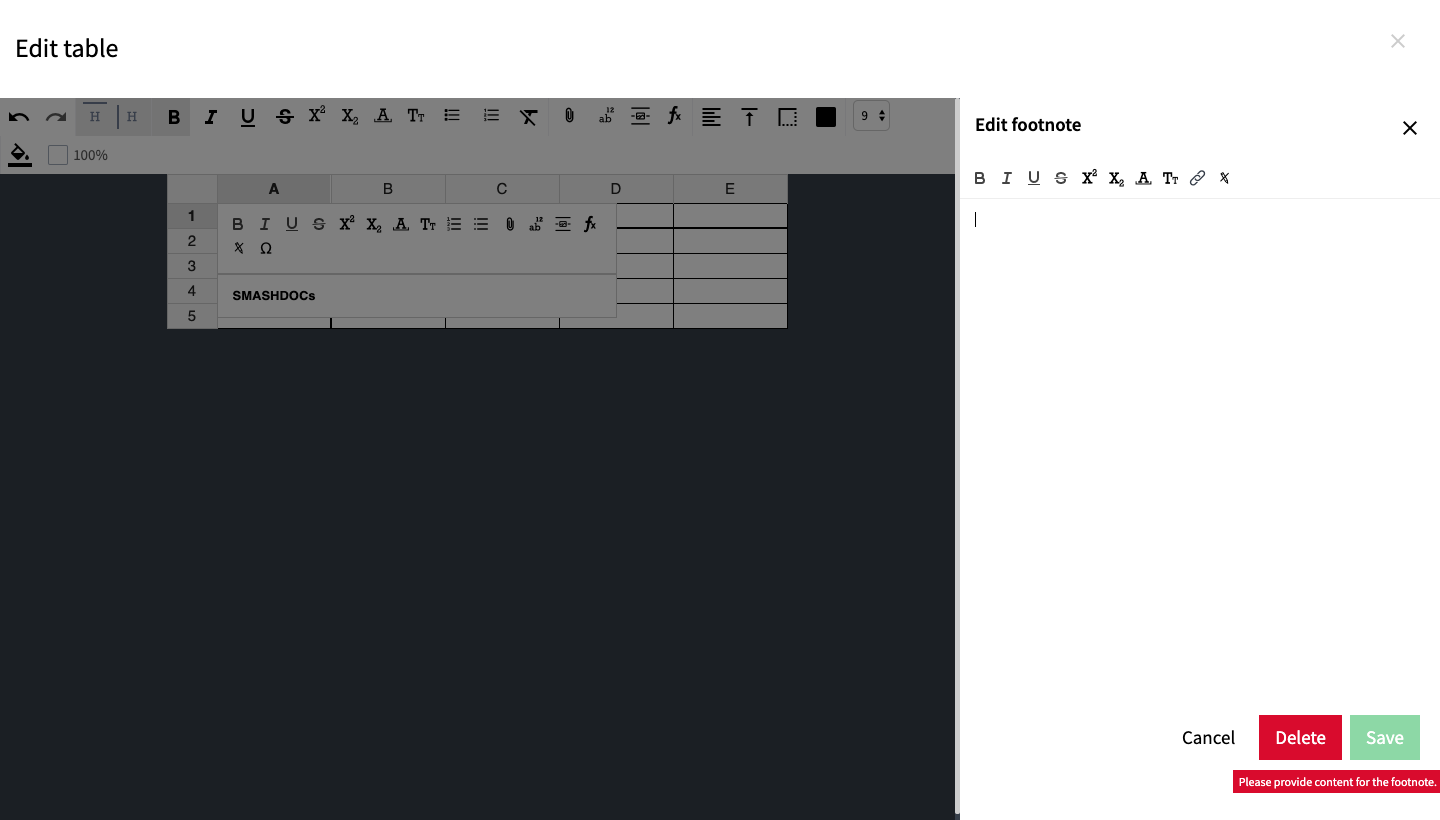
Adding footnote to the table component highlighted
Please keep in mind that saving of the footnote is not possible without content. The respective warning is displayed while creating a table footnote, and the "Save" button is being disabled until you insert some content.
8.1Creating table footnotes as draft components
After creating the new footnote to the table component, you can firstly create it as a draft component. It is only possible if your table is still in draft mode. Then, all of your newly created footnotes will be created as draft components below the table. Looks like this:
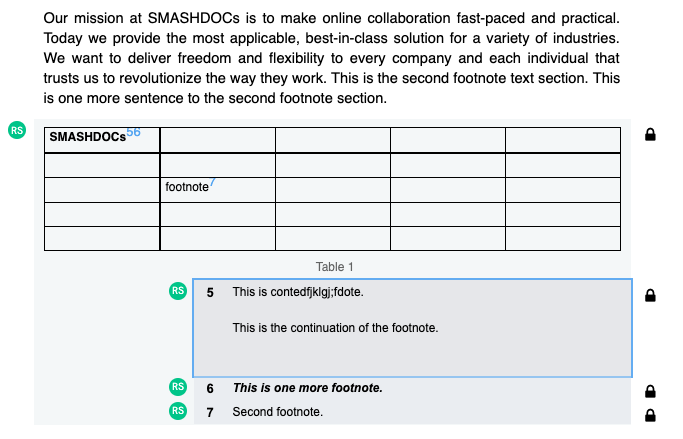
Footnote text components to the table component highlighted
8.2Creating table footnotes as review components
Instead, if you add footnote text components to the table in the draft mode, and share those for review right away, your table will automatically be shared for review as well.
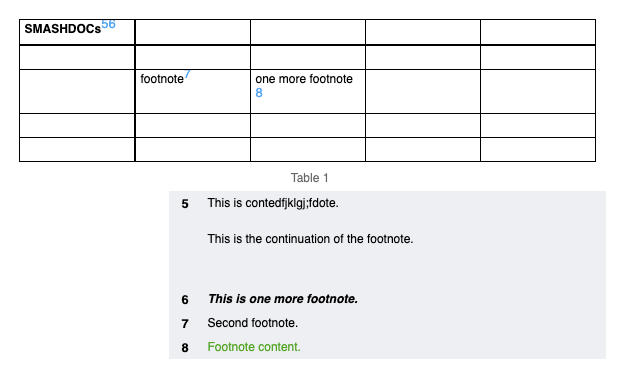
Table component and footnote text components shared for review highlighted
8.3Sharing table components with related footnotes
If you have created a table in the draft mode, added a draft table footnote and then shared the table for review, the created footnote will also be shared for review.
This way, you can draft the table, including related footnotes as long as you want while the document is in the review mode. But as soon as you decide to share your table, all footnote text components will be shared along too. Same, if you decide to share the footnotes to the table, the table as a leading component will be also shared for review.
Therefore, you can edit a table, then create several footnotes to the table, edit and delete some in draft mode and only then share the table inclusive the whole table component with table footnotes.
8.4Clicking on a footnote reference in the table component
If you click on a footnote in the table, SMASHDOCs will navigate you to the corresponding footnote text component in the list of table related footnotes.
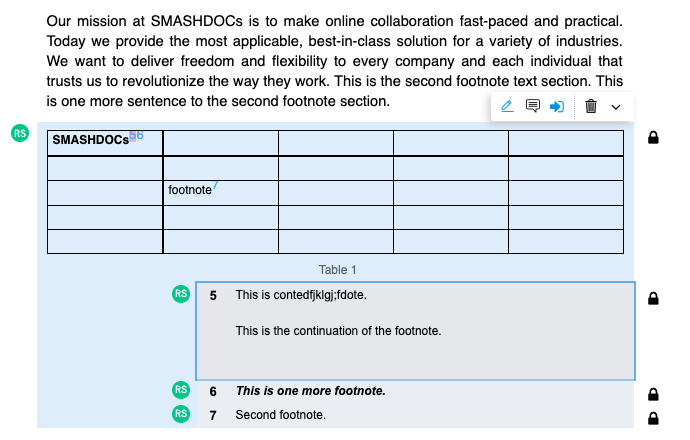
Footnote text component highlighted after clicking footnote reference in the table
8.5Edit / delete footnotes to the table components
Footnotes to table components can be edited and deleted as normal text components directly in the document. Details about footnote editing in the document see here 5 and about footnote deletion here 6.
9List of all footnotes in the document
The footnote text components directory contains all footnotes in the document and can easily be navigated. See more about it here 4.2.
10Export of footnotes
Footnotes are currently supported in:
●WORD export
●WORD import
●SDOX export
●SDOX import
Once the document is exported to WORD the footnote text components in SMASHDOCs get converted to standard footnotes in WORD.
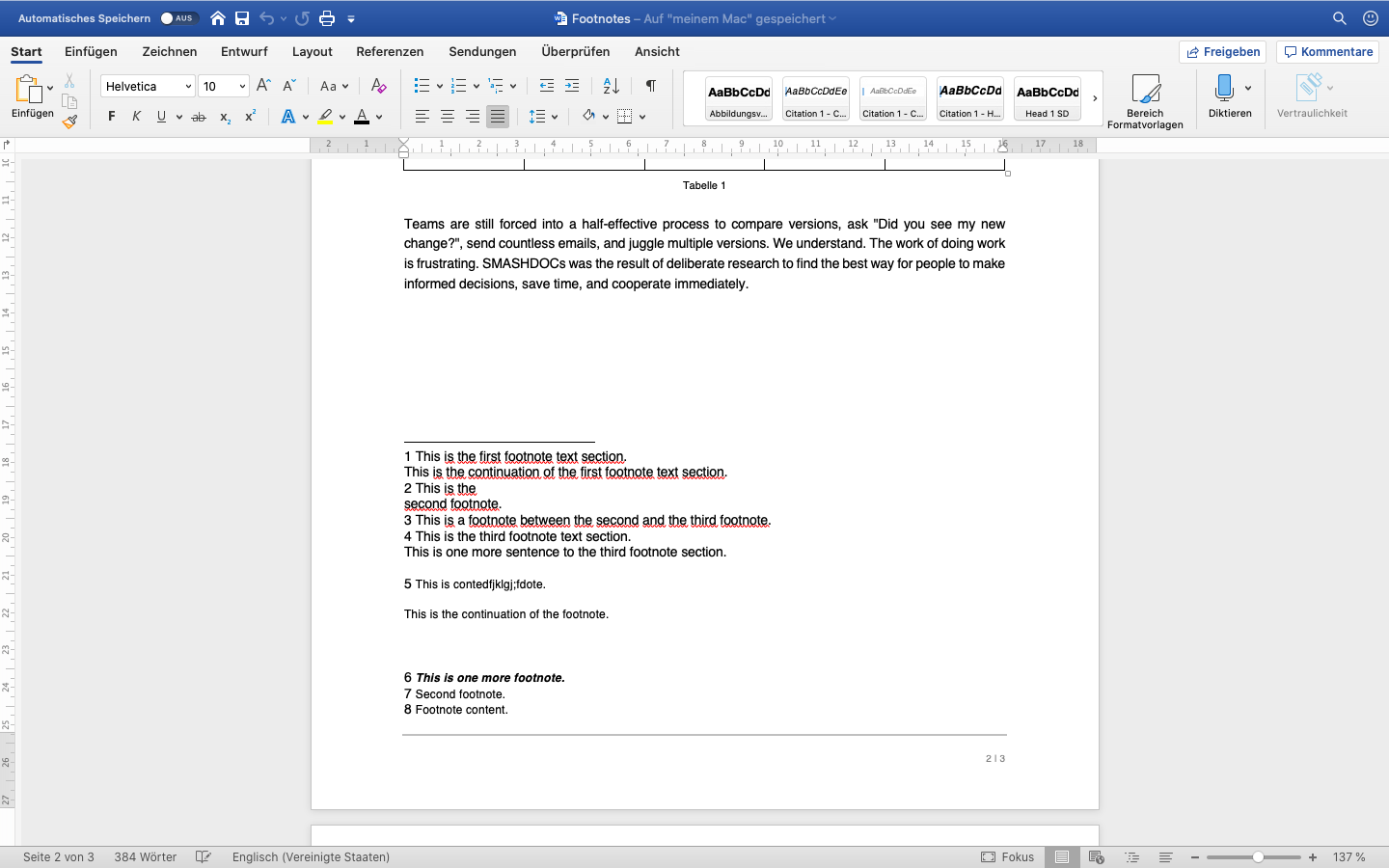
Footnote text components exported to WORD highlighted
But when this document is imported back to SMASHDOCs, the standard WORD footnotes get converted to custom footnote text components in SMASHDOCs.
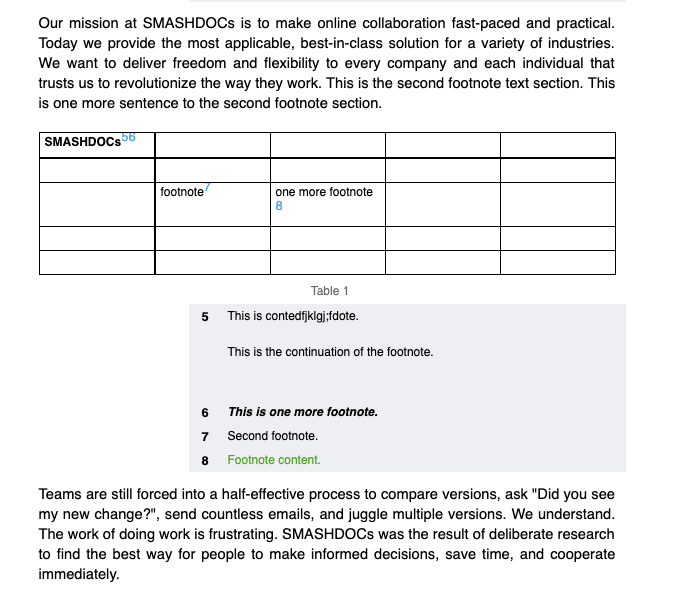
WORD document with standard footnotes imported back to SMASHDOCs
